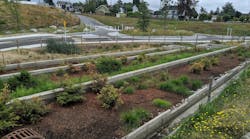The Innovative Stormwater Infrastructure Act made some progress in Congress last week; it was assigned to a congressional committee for consideration, possibly to be sent on to the House or Senate as a whole. Sponsored by Rep. Donna Edwards (D-MD) and Senator Tom Udall (D-NM), the act has two major goals: one is to improve water quality and the other is to provide jobs.
The act emphasizes “innovative” stormwater measures, particularly green infrastructure. It specifically mentions permeable pavement, natural drainage swales, and green roofs as alternatives to conventional stormwater infrastructure. A version of the bill was first introduced in 2013 by Rep. Edwards. You can read the full text of the act here.
According to a statement released by Rep. Edwards, the act will do several things to address water management:
* Promote the use of innovative stormwater solutions within the Environmental Protection Agency’s Office of Water and related programs and provide technical assistance to states, local governments, and the private sector;
* Invest in planning, development, and implementation grants for community-based stormwater control projects;
* Establish up to five Centers of Excellence in various regions of the US that would conduct research, develop recommendations, and provide training and technical assistance for implementing management practices for stormwater control and management; and
* Promote public-private partnerships to create jobs in the design and construction of innovative stormwater control infrastructure.
The Innovative Stormwater Infrastructure Act made some progress in Congress last week; it was assigned to a congressional committee for consideration, possibly to be sent on to the House or Senate as a whole. Sponsored by Rep. Donna Edwards (D-MD) and Senator Tom Udall (D-NM), the act has two major goals: one is to improve water quality and the other is to provide jobs.
The act emphasizes “innovative” stormwater measures, particularly green infrastructure. It specifically mentions permeable pavement, natural drainage swales, and green roofs as alternatives to conventional stormwater infrastructure. A version of the bill was first introduced in 2013 by Rep. Edwards. You can read the full text of the act here.
According to a statement released by Rep. Edwards, the act will do several things to address water management:
* Promote the use of innovative stormwater solutions within the Environmental Protection Agency's Office of Water and related programs and provide technical assistance to states, local governments, and the private sector;
* Invest in planning, development, and implementation grants for community-based stormwater control projects;
* Establish up to five Centers of Excellence in various regions of the US that would conduct research, develop recommendations, and provide training and technical assistance for implementing management practices for stormwater control and management; and
* Promote public-private partnerships to create jobs in the design and construction of innovative stormwater control infrastructure.
[text_ad]
It lists further goals:
* Improve our nation's ability to manage clean water resources, including drinking water;
* Increase research and development of innovative green infrastructure techniques;
* Create jobs across diverse sectors, such as plumbing, landscaping and engineering;
* Save taxpayer money by reducing the amount of water entering treatment plants, keeping energy costs low and prolonging the life of existing conventional water infrastructure; and
* Provide environmental and economic benefits to communities, including reduced flooding and energy use, as well as increased community greenspace and property values.
As it addresses polluted runoff, flooding, and combined sewer overflows, the act seems similar in intent to the thousands of municipal stormwater permits that are already in place. The Centers of Excellence and the technical assistance it promises, however, as well as more research and development on specific green infrastructure techniques, could benefit communities across the board.
What’s your take on the Innovative Stormwater Infrastructure Act—will it help further clean water interests, or is it redundant with existing legislation?
It lists further goals:
* Improve our nation’s ability to manage clean water resources, including drinking water;
* Increase research and development of innovative green infrastructure techniques;
* Create jobs across diverse sectors, such as plumbing, landscaping and engineering;
* Save taxpayer money by reducing the amount of water entering treatment plants, keeping energy costs low and prolonging the life of existing conventional water infrastructure; and
* Provide environmental and economic benefits to communities, including reduced flooding and energy use, as well as increased community greenspace and property values.
As it addresses polluted runoff, flooding, and combined sewer overflows, the act seems similar in intent to the thousands of municipal stormwater permits that are already in place. The Centers of Excellence and the technical assistance it promises, however, as well as more research and development on specific green infrastructure techniques, could benefit communities across the board.
What’s your take on the Innovative Stormwater Infrastructure Act—will it help further clean water interests, or is it redundant with existing legislation?
About the Author
Janice Kaspersen
Janice Kaspersen is the former editor of Erosion Control and Stormwater magazines.

